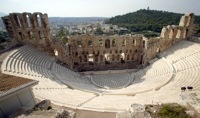Difference between revisions of "Amphitheater"
(Created page with 'File:lighterstill.jpgright|frame ==Etymology== Latin amphitheatrum, from Greek amphitheatron, from amphi- (around)...') |
m (Text replacement - "http://" to "https://") |
||
| Line 3: | Line 3: | ||
==Etymology== | ==Etymology== | ||
[[Latin]] amphitheatrum, from [[Greek]] amphitheatron, from amphi- (around) + theatron (a place for viewing) | [[Latin]] amphitheatrum, from [[Greek]] amphitheatron, from amphi- (around) + theatron (a place for viewing) | ||
| − | *Date: [ | + | *Date: [https://www.wikipedia.org/wiki/14th_Century 14th century] |
==Definitions== | ==Definitions== | ||
*1 : an oval or [[circular]] building with rising tiers of seats ranged about an open [[space]] and used in ancient [[Rome]] especially for contests and [[spectacle]]s | *1 : an oval or [[circular]] building with rising tiers of seats ranged about an open [[space]] and used in ancient [[Rome]] especially for contests and [[spectacle]]s | ||
| Line 12: | Line 12: | ||
*3 : a place of [[public]] [[entertainment]] (as for [[games]] or concerts) | *3 : a place of [[public]] [[entertainment]] (as for [[games]] or concerts) | ||
==Description== | ==Description== | ||
| − | An '''amphitheater''' is an open-air venue for [[spectator]] sports, concerts, rallies, or theatrical [[performances]]. There are two similar, but distinct, [[types]] of [[structure]] for which the word 'amphitheatre' is used: Ancient amphitheatres, built by the [ | + | An '''amphitheater''' is an open-air venue for [[spectator]] sports, concerts, rallies, or theatrical [[performances]]. There are two similar, but distinct, [[types]] of [[structure]] for which the word 'amphitheatre' is used: Ancient amphitheatres, built by the [https://en.wikipedia.org/wiki/Ancient_Rome ancient Romans], were large [[central]] [[performance]] spaces surrounded by [[ascending]] seating, and were commonly used for spectator sports; these [[compare]] more closely to modern open-air stadia. They were given this name because their shape resembled that of two theatres joined together. Modern amphitheatres (incorrectly so named, but the [[word]] has come to be used in this sense) are more typically used for theatrical or concert [[performances]] and typically feature a more [[tradition]]ally theatrical-style stage with the [[audience]] only on one side, usually at an arc of less than a semicircle; these compare more closely to the theatres of ancient [[Greece]], and have been more commonly built throughout [[history]] as [[performance]] spaces. Amphitheatres are typically man-made, though there are also [[geological]] formations used in the same [[manner]] which are known as [[natural]] amphitheatres. Special [[events]] and games were held in ancient [[Roman]] amphitheatres, such as the gladiator [[games]]. |
[[Category: General Reference]] | [[Category: General Reference]] | ||
Latest revision as of 23:42, 12 December 2020
Etymology
Latin amphitheatrum, from Greek amphitheatron, from amphi- (around) + theatron (a place for viewing)
- Date: 14th century
Definitions
- 1 : an oval or circular building with rising tiers of seats ranged about an open space and used in ancient Rome especially for contests and spectacles
- 2 a : a very large auditorium
- b : a room with a gallery from which doctors and students may observe surgical operations
- c : a rising gallery in a modern theater
- d : a flat or gently sloping area surrounded by abrupt slopes
- 3 : a place of public entertainment (as for games or concerts)
Description
An amphitheater is an open-air venue for spectator sports, concerts, rallies, or theatrical performances. There are two similar, but distinct, types of structure for which the word 'amphitheatre' is used: Ancient amphitheatres, built by the ancient Romans, were large central performance spaces surrounded by ascending seating, and were commonly used for spectator sports; these compare more closely to modern open-air stadia. They were given this name because their shape resembled that of two theatres joined together. Modern amphitheatres (incorrectly so named, but the word has come to be used in this sense) are more typically used for theatrical or concert performances and typically feature a more traditionally theatrical-style stage with the audience only on one side, usually at an arc of less than a semicircle; these compare more closely to the theatres of ancient Greece, and have been more commonly built throughout history as performance spaces. Amphitheatres are typically man-made, though there are also geological formations used in the same manner which are known as natural amphitheatres. Special events and games were held in ancient Roman amphitheatres, such as the gladiator games.
